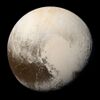Astronomy:(455502) 2003 UZ413
 Hubble Space Telescope image of 2003 UZ413 taken in 2008 | |
| Discovery[1] | |
|---|---|
| Discovered by | M. E. Brown D. L. Rabinowitz C. A. Trujillo |
| Discovery date | 21 October 2003 |
| Designations | |
| 2003 UZ413 | |
| Minor planet category | TNO[2] · plutino[3][4][lower-alpha 1] |
| Orbital characteristics[2] | |
| Epoch 27 April 2019 (JD 2458600.5) | |
| Uncertainty parameter 2 | |
| Observation arc | 63.25 years (23103 days)\ |
| Earliest precovery date | 29 July 1954 |
| |{{{apsis}}}|helion}} | 47.968 astronomical unit|AU (7.1759 Tm) |
| |{{{apsis}}}|helion}} | 30.241 AU (4.5240 Tm) |
| 39.104 AU (5.8499 Tm) | |
| Eccentricity | 0.22667 |
| Orbital period | 244.54 yr (89317.3 d) |
| Mean anomaly | 113.43° |
| Mean motion | 0° 0m 14.51s / day |
| Inclination | 12.04911° |
| Longitude of ascending node | 135.930° |
| 145.00° | |
| Physical characteristics | |
| Dimensions | 650+1 −175 km (upper limit)[5] 472+122 −25 km (lower limit)[5] |
| Mass | ≈3×1020 kg[lower-alpha 2] |
| Mean density | 2.29–3.00 > ρ >0.72 g/cm3[6] 2.64 g/cm3[7] |
| Sidereal rotation period | 4.13±0.05 h[6][8] 4.14 h[2] |
| Geometric albedo | 0.075+0.076 −0.006 (lower limit)[5] 0.151+0.025 −0.064 (upper limit)[5] |
| V–R=0.45±0.04[5] BB taxon (blue/neutral)[7][9][lower-alpha 3] V−R=0.46±0.06 R−I=0.37±0.06[9] | |
| Apparent magnitude | 21[10] |
| Absolute magnitude (H) | 4.38±0.05[5] 4.3 (assumed)[2] |
(455502) 2003 UZ413 (provisional designation 2003 UZ413) is a trans-Neptunian object (TNO) with an absolute magnitude of 4.38.[5] It is in a 2:3 orbital resonance with Neptune, thus it is classified as a plutino.[3] There are indications it may be dense enough to be a dwarf planet. It was given the minor planet number 455502 on 22 February 2016.[11]
2003 UZ413 has been observed 79 times over 15 oppositions, with precovery images back to 27 July 1954.[2]
Orbit and rotation
2003 UZ413 is in a 2:3 resonance with Neptune, which means that when it makes two revolutions around the Sun, Neptune makes exactly three.[3]
The object rotates very fast. In fact, with a period of about 4.13 hours, it is the fastest rotator known in the Kuiper belt after Haumea.[6][8]
Physical characteristics
The mean diameter of 2003 UZ413 is estimated to be 650+1
−175 km, assuming a low albedo.[5]
Given its rapid rotation, it must have a density higher than 0.72 g/cm3.[6] Stable Jacobi ellipsoids with an axis ratio of a/b ≥ 1.13±0.03, as implied by its light-curve amplitude of Δm = 0.13±0.03, exist for densities in the range of 2.29−3.00 g/cm3.[6] The Johnston's Archive settles on 2.64 g/cm3,[7] the centre of the latter range; for a 600 km equivalent spheroid body, this would equate to a mass of approximately 3.0×1020 kg. The extremely high estimated density (in contrast to any known similarly sized TNO)[12] would make it virtually certain that this object is a dwarf planet, but confirmation would require additional observation to refine the size and light curve details, preferably with discovery of a satellite to determine its mass.
In visible light, this object is neutral or slightly red in color and has a flat, featureless reflectance spectrum.[8]
Notes
References
- ↑ Brown, M.; Trujillo, C.; Rabinowitz, D.; Marsden, B. G. (2007-09-01). "2003 UY413, 2003 UZ413, 2004 NT33, 2005 CA79, 2005 CB79, 2005 UQ513". Minor Planet Electronic Circulars 2007-R02: 02. MPEC 2007-R02. Bibcode: 2007MPEC....R...02B.
- ↑ 2.0 2.1 2.2 2.3 2.4 "JPL Small-Body Database Browser: (2003 UZ413)". https://ssd.jpl.nasa.gov/sbdb.cgi?sstr=2003UZ413. Retrieved 19 August 2019.
- ↑ 3.0 3.1 3.2 Marsden, B. G. (2008-07-17). "Distant Minor Planets". Minor Planet Electronic Circulars. MPEC 2008-O05. https://www.minorplanetcenter.net/mpec/K08/K08O05.html. Retrieved 3 December 2010.
- ↑ Marc W. Buie (2015-09-24). "Orbit Fit and Astrometric record for 2003 UZ413". SwRI (Space Science Department). http://www.boulder.swri.edu/~buie/kbo/astrom/03UZ413.html. Retrieved 2019-08-19.
- ↑ 5.0 5.1 5.2 5.3 5.4 5.5 5.6 5.7 Farkas-Takács, A. et al. (28 February 2020). ""TNOs are Cool": A survey of the trans-Neptunian region". Astronomy & Astrophysics 638: A23. doi:10.1051/0004-6361/201936183.
- ↑ 6.0 6.1 6.2 6.3 6.4 Perna, D.; Dotto, E.; Barucci, M. A.; Rossi, A.; Fornasier, S.; de Bergh, C. (2009). "Rotations and densities of trans-Neptunian objects". Astronomy & Astrophysics 508 (1): 451–455. doi:10.1051/0004-6361/200911970. Bibcode: 2009A&A...508..451P. http://www.aanda.org/index.php?option=com_article&access=standard&Itemid=129&url=/articles/aa/abs/2009/46/aa11970-09/aa11970-09.html. Retrieved 1 June 2019.
- ↑ 7.0 7.1 7.2 William Robert Johnston. "List of known trans-Neptunian objects". Johnston's Archive. http://www.johnstonsarchive.net/astro/tnoslist.html. Retrieved 2019-08-19.
- ↑ 8.0 8.1 8.2 Fornasier, S.; Barucci, M. A.; de Bergh, C.; Alvarez-Candal, A.; Demeo, F.; Merlin, F.; Perna, D.; Guilbert, A. et al. (2009). "Visible spectroscopy of the new ESO large programme on trans-Neptunian objects and centaurs: Final results". Astronomy and Astrophysics 508 (1): 457–465. doi:10.1051/0004-6361/200912582. Bibcode: 2009A&A...508..457F. http://www.aanda.org/articles/aa/pdf/2009/46/aa12582-09.pdf.
- ↑ 9.0 9.1 Perna, D. et al. (2010). "Colors and taxonomy of centaurs and trans-Neptunian objects". Astronomy and Astrophysics 510: A53. doi:10.1051/0004-6361/200913654. Bibcode: 2010A&A...510A..53P.
- ↑ "2003 UZ413 Ephemerides". Asteroids Dynamic Site. Archived from the original on 2019-08-19. https://web.archive.org/web/20190819164700/https://newton.spacedys.com/astdys/index.php?pc=1.1.3.0&n=455502. Retrieved 2019-08-19.
- ↑ 11.0 11.1 "(455502) 2003 UZ413 Precovery Images". http://andrew-lowe.ca/2003uz413.htm. Retrieved 28 April 2019.
- ↑ Grundy, W.M.; Noll, K.S.; Buie, M.W.; Benecchi, S.D.; Ragozzine, D.; Roe, H.G. (December 2019). "The Mutual Orbit, Mass, and Density of Transneptunian Binary Gǃkúnǁʼhòmdímà ((229762) 2007 UK126)". Icarus 334: 30–38. doi:10.1016/j.icarus.2018.12.037. Bibcode: 2019Icar..334...30G. http://www2.lowell.edu/~grundy/abstracts/2019.G-G.html. Retrieved 2019-11-06.
External links
 |




